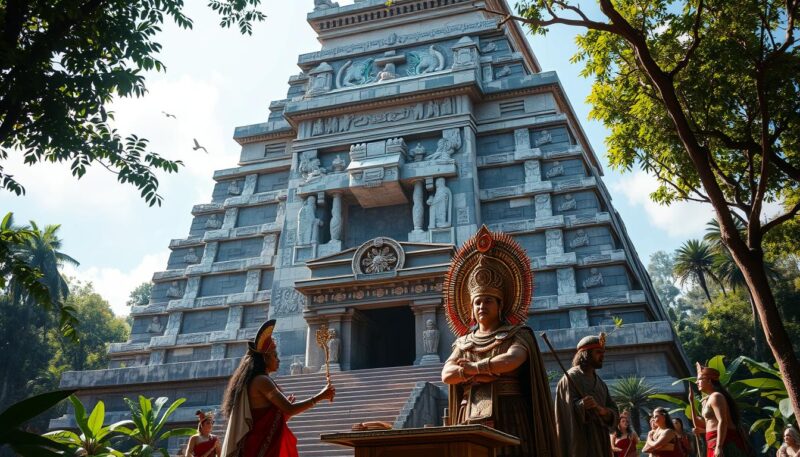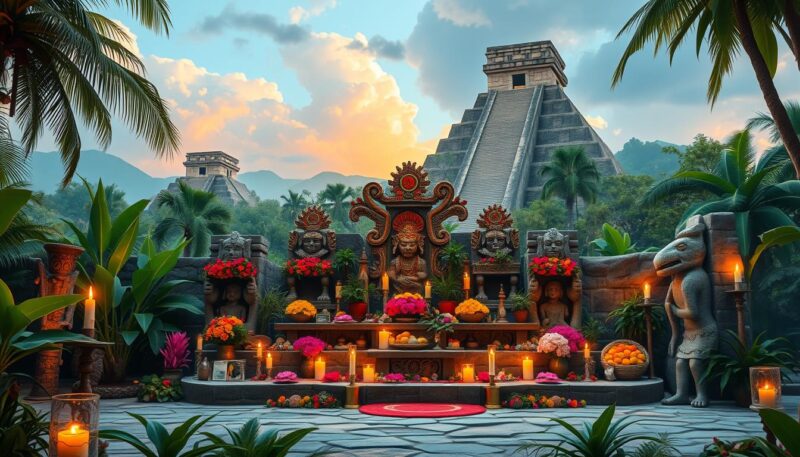The ancient Maya civilization is a fascinating testament to the spiritual and cultural richness of Mesoamerica. Known for their intricate social structures and profound reverence for the divine, the Maya infused their everyday lives with practices that honored their gods, rulers, and the dead. At the heart of Maya culture lies a complex web of beliefs, rituals, and traditions that shaped their worldview. The Maya viewed themselves as integral parts of a vast cosmos, where the divine influenced earthly matters, guiding their agricultural practices, societal hierarchy, and even the treatment of the deceased. With a history that spans thousands of years, this civilization left behind a legacy of myths, art, and architectural marvels, including remarkable sites like Tikal and Chichen Itza. Through anthropological studies and insights from texts such as the Popol Vuh, we can appreciate how these ancient people celebrated life and death, ensuring a connection that transcended the physical realm.
From elaborate rituals involving bloodletting to funerary practices filled with symbolism, the ways the Maya paid homage to their creators and ancestors reflect a culture steeped in spiritual understanding. These customs were not merely acts of devotion; they were key components of social identity and communal cohesion. The traditions surrounding the honoring of the dead, particularly in funerary contexts, reveal how the Maya viewed the afterlife as a continuation of existence rather than an end. The presence of maize in burials, for example, exemplifies their beliefs in the cyclical nature of life and rebirth. Join us as we explore the myriad ways in which the ancient Maya honored their gods and departed, weaving together their profound traditions and the remarkable legacies that continue to inspire modern-day Maya descendants.
The Role of Gods in Mayan Traditions
The ancient Maya held an intricate belief system centered around their many gods, which greatly influenced their culture and spiritual practices. The pantheon comprised over 250 deities, each integral to the various aspects of life, agriculture, and natural elements. Major deities like Itzamna, the god of creation, and Chaac, the rain god, served vital roles in community survival and prosperity.
Main Deities of the Ancient Maya
Among the major deities, the creation myths reveal varied stories of how humans were formed, including tales of thirteen gods crafting humanity from maize in the Quiche version. The Yucatec myth emphasizes only two gods in the same process. Powerful figures like Ahau-Chamahez and Cit-Bolon-Tun represented divine medicine, while Bacabs presided over the winds, connecting the cosmic elements with daily life. The evolution of these beliefs traces back to around 250 AD, marking the rise of Mayan civilization and its complex spirituality.
The Importance of Ritual Offerings
Ritual offerings established a significant connection between the Maya and their gods. These included food, incense, and in some cases, ritual sacrifices, such as self-bloodletting or even human offerings. These practices aimed to maintain harmony with the deities, ensuring balance within the community and promoting agricultural success. Such rituals were deeply woven into the spiritual practices of the Maya, acting as a means of communication with the divine.
Connection Between Deities and Natural Elements
The spiritual landscape of the Maya was heavily influenced by natural elements. Gods represented aspects such as rain, fertility, and agriculture, establishing a crucial bond between the environment and spirituality. The great Temple of Kukulcan at Chichen Itza exemplifies this relationship, aligning with the Haab calendar and the cycles of nature. This temple not only embodied the integration of celestial events with earthly realities but also drew crowds twice a year during equinoxes to witness significant rituals related to corn and rain.
Mayan Traditions and Ritual Practices
The ancient Maya civilization celebrated a rich tapestry of traditions marked by elaborate ceremonies, particularly those surrounding their rulers. These Mayan king ceremonies played a pivotal role in reinforcing the connection between the rulers and the divine. Sacred Mayan temples served as the backbone for these important rituals, acting as spiritual hubs where the community gathered to honor their gods. Agricultural festivals formed another essential component of their religious practices, intertwining agriculture with their spiritual beliefs and cyclical understanding of time.
Ceremonies for the Rulers
Mayan king ceremonies often featured a medley of rituals designed to affirm the king’s divine right to rule. Notably, ceremonies like the Ch’ajoomte’ (Naming Ceremony) and the Ix K’ab’ Tzi’ (First Menstruation Ceremony) illustrated the community’s role in supporting royal lineage, aligning individual milestones with broader cosmological beliefs. The importance of these rites was amplified during significant events, such as the K’atun Ending Ceremony, which sought favor from the gods as the society transitioned into a new cycle.
Significance of Sacred Temples
The sacred Mayan temples served as vital loci for these ceremonies, acting not just as physical structures, but as symbolic embodiments of the interconnectedness of the earthly and the divine. These sites hosted rituals associated with celestial events, such as the Kukulkan Equinox Ceremony at Chichen Itzá, where light patterns during equinoxes represented the god’s presence. Ritual practices in these temples included offerings of incense, food, and, at times, self-mutilation by rulers, demonstrating a profound commitment to appeasing the gods.
The Cycle of Agricultural and Religious Festivals
Agricultural festivals formed the backbone of Mayan religious practices, intricately linked to seasonal changes. Ceremonies such as the Yum Kaax Ceremony and the Sowing Ceremony were crucial to blessing seeds and ensuring bountiful harvests. The cyclical nature of these events highlighted the strategy of aligning agricultural activities with the spiritual calendar, which included the Tzolk’in and Haab’ calendars. Key festivities like Hanal Pixán (Day of the Dead) not only honored the deceased but also served as a reminder of the importance of continuity within the community.
| Ceremony | Purpose | Key Features |
|---|---|---|
| Ch’iyaj (New Fire Ceremony) | Marks the end of a cycle | Occurs every 52 years |
| Yum Kaax Ceremony | To ensure bountiful harvests | Rituals dedicated to the god of agriculture |
| Kukulkan Equinox Ceremony | Symbolizes the arrival of the deity | Light patterns during equinoxes |
| Hanal Pixán (Day of the Dead) | Honors deceased loved ones | Family altars and offerings |

Mayan Funerary Customs and Ancestral Worship
The Mayan funerary customs reflect a deep reverence for the deceased and the belief in an afterlife. When a member of the community passed away, burial rites were meticulously observed. The Maya often interred their dead beneath household floors or platforms, creating a direct connection between the living and the departed. Archaeological evidence suggests that these practices have existed since the Early Middle Pre-Classic period and continued into the sixteenth century, demonstrating how vital these customs were to the Maya’s social fabric. By placing their ancestors within their living spaces, families maintained a close relationship with their deceased, fostering a lasting legacy of ancestor worship.
During funerals, the Maya would include significant offerings, such as jade and maize, items thought to enhance the deceased’s journey in the afterlife. The interment process involved elaborate rituals designed to honor the deceased, ensuring a smooth transition to the underworld, known as “xibalba.” Additionally, the act of cremation marked a noteworthy stage in the ritual process, signifying the severance from earthly life. Elders in families often engaged in practices that included praying to the departed during the winter solstice, showcasing a continued respect and connection to their lineage.
In modern times, the essence of these ancient rituals remains alive in the annually celebrated Day of the Dead, which highlights the continuity of ancestor worship within contemporary Mayan communities. Although today many Maya people use cemeteries, the tradition of interring loved ones on personal land persists, signifying the duality in burial practices that honor both individual and communal identities. This enduring cultural trait illustrates how Mayan funerary customs not only facilitated the passage of souls but also served as a critical bridge linking generations through respected names and memories.

